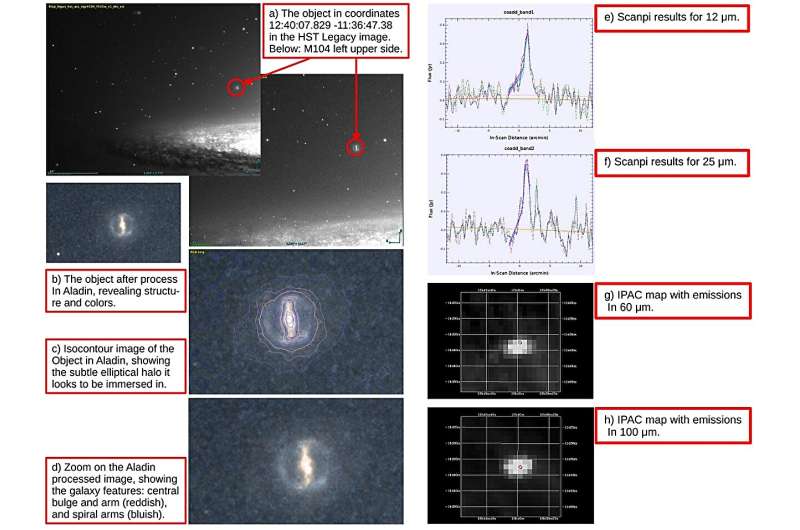August 21, 2023 report
This article has been reviewed according to Science X's editorial process and policies. Editors have highlighted the following attributes while ensuring the content's credibility:
fact-checked
preprint
trusted source
proofread
Spanish astronomer discovers new active galaxy

By analyzing the images of the Sombrero Galaxy obtained with the Hubble Space Telescope (HST), Elio Quiroga Rodriguez of the Mid Atlantic University in Spain, has identified a peculiar object, which turned out to be a galaxy hosting an active galactic nucleus (AGN). The finding was reported in a paper published August 11 on the pre-print server arXiv.
An AGN is a compact region at the center of a galaxy, more luminous than the surrounding galaxy light. Studies show that AGNs are very energetic due either to the presence of a black hole or star formation activity at the core of the galaxy.
Astronomers generally divide AGNs into two groups based on emission line features. Type 1 AGNs show broad and narrow emission lines, while only narrow emission lines are present in Type 2 AGNs. However, observations revealed that some AGNs transition between different spectral types; therefore, they were dubbed changing-look (CL) AGNs.
Sombrero Galaxy (also known as Messier 104 or NGC 4594) is an unbarred spiral galaxy located between the borders of the Virgo and Corvus constellations, some 31 million light years away. With a mass of about 800 billion solar masses, it is one of the most massive objects in the Virgo galaxy cluster. It also hosts a rich system of globular clusters.
Rodriguez has recently investigated HST images of the Sombrero Galaxy, focusing one particular object in its halo. He found that this object, previously classified as a globular cluster candidate, may be a barred spiral galaxy of the SBc type, with an AGN at its center.
"While studying HST images available on the HST Legacy website of the halo of M104 (HST proposal 9714, PI: Keith Noll), the author observed at 12:40:07.829-11:36:47.38 (in j2000) an object about four arcseconds in diameter. A study with VO tools suggests that the object is a SBc galaxy with AGN (Seyfert)," the paper reads.
The object is cataloged in the Pan-STARRS1 data archive as PSO J190.0326-11.6132. By analyzing the data from the Aladin Sky Atlas RGB Rodriguez found that PSO J190.0326-11.6132 is a galaxy with a dominant central arm, nucleus and possibly two spiral arms with hot young stars and dust. The astronomer proposes that the newfound galaxy should be named the "Iris Galaxy."
The study found that PSO J190.0326-11.6132 has a radial velocity at a level of 1,359 km/s. Rodriguez assumes that the object, if gravitationally bound to the Sombrero Galaxy, could be its satellite with an angular size of around 1,000 light years.
However, the author of the paper noted that if the Iris Galaxy is not associated with the Sombrero Galaxy, its distance may be some 65 million light years. In this scenario, the angular size of the newly detected should be about 71,000 light years.
The X-ray emission luminosity of the Iris Galaxy was measured to be approximately 18 tredecillion erg/s, assuming a distance of 65 million light years. Such luminosity indicates the presence of an active galactic nucleus, however further observations are required in order to determine whether this is a Type 1 or Type 2 AGN.
More information: E. Quiroga, A peculiar galaxy near M104, arXiv (2023). DOI: 10.48550/arxiv.2308.06187
Journal information: arXiv
© 2023 Science X Network




















